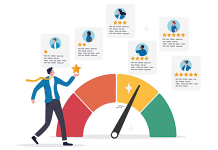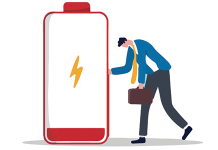Implementing enterprise software has never been easy. And this hasn’t changed, even with software as a service (SaaS) and cloud-based technology. An original promise of SaaS was that it would take the pain away from internal IT personnel and transfer it instead to the technology vendor, which specializes in the thankless job of establishing the optimal hosting environment and maintaining the software for many clients at once. Managing the technology, however, is just the first hurdle. Business objectives can be complex and often political, end customer expectations are even more demanding in the digital age, and enterprise regulatory and compliance needs have increased.
While user adoption and change management have always been the most critical of requirements of a new software implementation, SaaS vendors know that expansion and renewals depend upon satisfied users and ROI. In this article, I will discuss the challenges in the B2B SaaS customer experience and how to tackle these potential barriers upfront – rather than trying to do damage control months into the implementation when the customer is annoyed, disappointed, and on the path to churn.
Top Risk Factors in B2B SaaS Customer Success
From many years of experience in customer-facing roles with large software companies, I’ve learned that there are many factors which can break a customer relationship after the sale. Fortunately, most of these can be prevented, but with the SaaS model, it’s even more important to closely track customer sentiment and improve iteratively. Here are the red flags to watch out for:
Mediocre first experience – During the pre-sales process, software companies bring out an army of experts across sales, support and engineering to wow the prospect and seal the deal. However, the right level of customer engagement after the contract is signed is integral to success, especially during those early weeks when so much is at stake. The key steps include agreeing on the statement of work (SOW), assigning onboarding resources, identifying current and future users and roles, building integrations, delivering role-based training and providing a dedicated support team with established processes and regular check-ins.
Slow time to value – Depending upon the product and SOW, a vendor may have two or three phases of deployment at the customer site. Too often, the initial implementation cycle takes too long. In the sales process, the vendor may give a timeline of 4-6 weeks, but this is only possible when the customer has the adequate internal IT resources to commit to the project and if there isn’t scope creep. When deadlines and SLAs are not achieved, the customer’s faith begins to wane and this can create long-term trust issues. It’s up to the SaaS vendor to create realistic expectations for phase one and set forth clear guidance on what the customer needs to complete on their end (like security clearances) to keep the wheels moving forward.
Adoption hurdles – Given the complexities of today’s digital landscape, it is not sufficient to provide self-service support alone, even for a simple product. Post Go-Live, enterprise technology customers tend to feel stranded and lost in space. If these sentiments are not addressed, it can hinder adoption and ruin your company’s reputation. Work in lockstep with the customer to ensure that the primary use cases are being adopted with high customer satisfaction to ensure long term growth. Another key hurdle during adoption is the lack of perceived value. Establishing and agreeing upon the right success metrics, understanding usage statistics, reviewing pain points on a regular basis and building a mutual success plan can help head off real issues down the road.
Billing issues – Most SaaS companies are using or moving to a usage-based or metered billing model due to customer demand. While metered billing offers flexibility and can be a key differentiation, the complexities of contracts, discounts and pricing on metered billing can be an area of concern for customers. Maintaining billing transparency is crucial to building credibility, assurance and trust among enterprise customers.
Covering the Bases
To deliver a world-class customer experience, focus on people skills, a personalized service and a thorough measurement program.
- Build your team thoughtfully. Find the people who are able to understand and share the customer urgency and not only validate concerns but anticipate them. The best team members have excellent (and nuanced) social skills. They are proactive, accountable, always calm, and communicate frequently with customers. They also need a solid mix of technical knowledge and strategic knowledge, providing a 360° view of the account.
- Create a white glove service. Since business objectives and outcomes vary across your customers, the service offering should be personalized to the customer’s requirements. The customer success manager is the perfect ambassador here, striving to achieve a product-customer fit by tracking and communicating value based on mutually agreed and measurable business outcomes. Initially, holding several calls per week to review and proactively address any challenges and troubleshoot issues diplomatically with the customer executive is a best practice. This effort can be worthwhile to avoid timeline slips, catch small issues before they escalate and hasten time to value. Make sure you have the right mix of people on these calls – including support, engineering, product management and in some cases, marketing. Bringing a cross functional group of your best people shows the customer that you care and can attend to all of their needs and can foster loyalty through any rough patches ahead.
- Measure and refine. Companies should invest in several tools to measure key customer adoption and behavior metrics and milestones. Some of those include Walk Me, Pendo, ZenDesk, and Gainsight. Strive to integrate these tools and datasets so that you can have a single view of the customer. The CRM system can be a great place to deliver the high level view, allowing sales, support and marketing to be on the same page. It’s also a smart idea to measure overall customer satisfaction (CSAT, NPS) with regular surveys using tools like SurveyMonkey or Qualtrics.
- Develop customer evangelists. Aligning customer success with marketing programs should be a process embedded in the customer journey. Being a customer evangelist can mean sharing best practices on webinars, speaking at conferences and building your personal brand as practitioner and influencer. Create programs that are a win-win for your company and customers through incentives for active participation, such as early access to beta programs or invitations to customer advisory boards.
B2B SaaS customer success is not something to think about after the enterprise contract has been signed. Rather than an afterthought, the customer engagement journey is critical to the success of the implementation, customer satisfaction and long-term customer loyalty. By embedding great practices, teams and tools into your pre-sales and post-sales processes, you can increase renewals and develop the kind of stellar customer references that will enhance your company’s reputation for years to come.
Kaveri Kalavath is director of customer success and solution architecture at OpsRamp.




